Building a Bluetooth radio
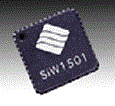
Manufacturers of Bluetooth solutions are looking for the right balance between performance and cost in this consumer-driven market.
Table of Contents
Process technology
Performance
Technological Issues
Cost & Other Issues
Conclusion
A complete Bluetooth module consists of an antenna, radio, baseband processor, a protocol stack, and perhaps a link manager, with the most complex part of the solution being the radio. Current Bluetooth design efforts in this RF space include decisions about process technology, performance trade-offs, and cost reduction. The Bluetooth-defined cost target is US$5 per module, and since the radio is likely to account for approximately 80% of this cost, cost reduction is a major driver in current design efforts. While it is likely that first generation Bluetooth radios will not meet this target, most expect to eventually hit the target.
Process Technology
Steve Brown, Senior Director of Bluetooth Products, Silicon Wave, Inc. (San Diego, CA), stresses that "low cost for consumer products, high levels of integration to maintain radio performance, and ease of manufacture" are all very important specifications for a Bluetooth radio. (See related article). These factors have led to somewhat of a debate over which process technology will be best for implementing the radio, with the major tradeoffs seen as cost versus performance.
Navin Sabharwal, Director of Residential Technologies, Allied Business Intelligence (Oyster Bay, NY), explains that most manufacturers are taking one of three positions: implementing the entire Bluetooth module in CMOS, implementing the radio in CMOS and the baseband in BiCMOS (with plans to integrate later), or staying with SiGe or BiCMOS designs for now and seeing how the CMOS efforts develop. (See related article).
The advantages of an all CMOS design, such as those proposed by Cambridge Silicon Radio (Cambridge, UK), include cost savings, potentially easier system-on-chip (SOC) integration for the entire module, and worldwide established high-volume fabrication facilities. "There are some concerns about a CMOS radio, however, because they are still only in the prototype stage," explains Sabharwal. "For instance, how will they perform? And, what kind of yield will we see in production volumes?" Recent announcements by Taiwan Semiconductor Manufacturing Company Ltd. (TSMC; Taiwan) and Chartered Semiconductor Manufacturing (Singapore) regarding their capabilities for fabricating pure CMOS radios in 0.18 µm are encouraging, with production volumes expected by 2001. (See related article).
While a CMOS design certainly looks promising, Sabharwal notes that the market is starting to exert pressure for delivery of the much-publicized Bluetooth solutions. As a result, many manufacturers – such as Philips, National Semiconductor, and Silicon Wave – are designing the radio portion of the solution in proven BiCMOS or SiGe implementations, which allows them to get products to market right now.
"Philips Semiconductors is using a sophistical and proven RF process (QUBiC3) for Bluetooth radio ICs," reports Ferrer. "It is the same process used to produce vast numbers of radio ICs for mobile and digital cordless phones. Thanks to the high volume involved, high yields are achieved, resulting in very cost effective and efficient products." (See related article). In fact, Philips has already released its UAA3558V Bluetooth transceiver (See Figure 1) and plans a low-power consumption version for January 2001. The company also reports plans to release two Bluetooth RF modules in 4Q of this year.
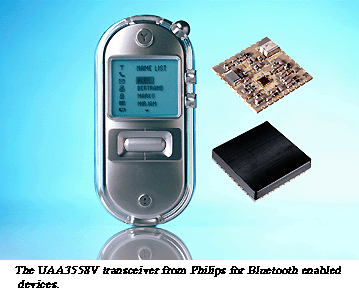
Silicon Wave uses a BiCMOS silicon on insulator (SOI) process, and currently has available its SiW1501 Radio Modem IC (See Figures 2 & 3) as well as its SiW1601 Link Controller IC and Bluetooth Protocol Stack (lower layer).
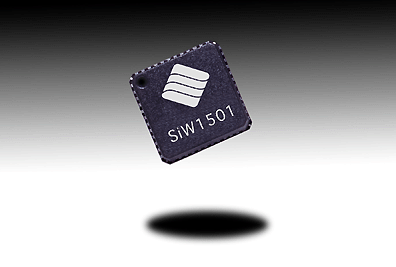
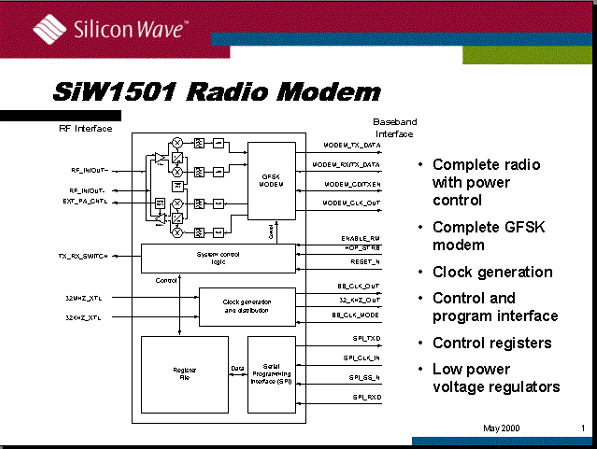
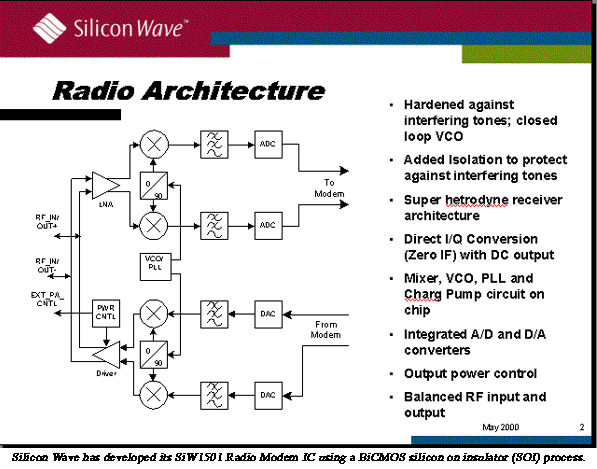
Performance
The major performance concerns for a Bluetooth radio include sensitivity—how well it makes connections—and range. Sabharwal characterizes the performance requirements of the Bluetooth specification as "relaxed radio parameters." This is due to the initiative's focus on low cost and satisfactory performance rather than on excellent performance. As a result, an RFIC in a Bluetooth solution requires sensitivity of better than –80 dBm, power consumption of better than 40 mA at 2.6 V, a robust link, and high volume production capability, according to Francisco Ferrer, International Product Marketing Manager for Bluetooth at Philips Semiconductors. Sabharwal is somewhat concerned about the lack of emphasis on performance, especially given the likelihood of congestion in the 2.4 GHz band when Bluetooth, 802.11b, and HomeRF systems begin to proliferate the market.
Technological Issues
While some design issues might remain for the CMOS radios that are still in the prototype stage, those pursuing BiCMOS processes report minimal design issues. However, as with all of the communications efforts to move towards a SOC solution, integration is a key design concern. "High levels of integration and direct conversion were paramount to our success in designing our radio modem," explains Brown. "Combined with good RF design, there was a lot of digital circuitry to include on one die," he adds. Both Philips and Silicon Wave credit proven and advanced architectures with enabling integration. "Advanced architectures such as direct conversion are required to ensure that performance and power consumption are not jeopardized by greater integration," says Brown.
Cost & Other Issues
Bluetooth is a standard that is expected to proliferate in high volumes around the globe, and, since its inception, low cost has been a major driver. Current modules are selling at approximately $25 each, but vendors are working hard to drive costs down.
According to a report published last December by Strategies Unlimited (Mountain View, CA), Bluetooth chip/module usage in handsets and hands-free headsets for cellular phones are anticipated to reach 7,000,000 units this year, 16,000,000 in 2001, and extend to 113,000,000 by 2004. (The forecast did not include usage in personal digital assistants [PDAs] or other peripheral devices.) (See related article). At these volumes, George Bechtel, Director of the Wireless Program at Strategies Unlimited, sees packaging as another issue which might impact cost, with the design choice primarily between a quad flatpack (QFP) or multichip module (MCM) implementation. "The current trend is MCM, and there are already a number of implementations, such as the one from Ericsson," Bechtel reports.
Interoperability is often voiced as a concern with any Bluetooth product, and it is the concern that the specification hopes to overcome. Bechtel wonders, "Will all of the current players be able to interpret the Bluetooth specifications in a way that will allow different products to talk to each other?" He anticipates that they will, expecting some of the early chip or module suppliers to lead the market and the others have to follow with a compatible product. Manufacturers are very concerned about preserving interoperability; Brown reports that he sees his company's next steps as continuing the "interoperability and certification processes."
Conclusion
As Bluetooth radios begin to roll into production in the next few months, it is likely that everyone will be closely watching the success and yields of all-CMOS radio designs. With the current emphasis on cost, the process that eventually enables the lowest cost module is likely to prevail.
About the author…
Janine Sullivan is a contributing writer for RF Globalnet. She is also the former editor of Communications Products magazine and the founder and owner of The Write Solution, a technical writing agency. Janine can be reached at The Write Solution, write@interactive.net.
Edited by Gregg Miller
